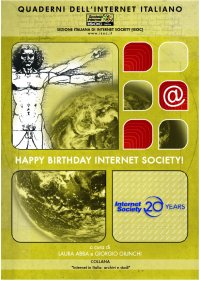- IETF was
born in January 1986 as a very small group (21 people) of researchers who
met in San Diego (California) under the original name of "DARPA -
Gateway Algorithms and Data Structures Task Force"; this name was
changed at that meeting into IETF for the first time.
- Unitil
1990 activities ran as an informal group of experts which published informal
"Requests For Comments" (RFCs), whose implementaion was then
accomplished inside programmes and devices avaialble on the network.
- As a "formal
organisational structure" was missing, a number of practical-administrative-legal
problems started to happen to IETF activities, and in the early '90s they
became quite evident.
- Besides
logistics activities (to make IETF work more and more people were needed,
an administration, a financial office, somebody to negotiate with hosting
sites), also intellectual property rights handling in an appropriate way
was needed.
- Furthermore,
we needed an organisation capable of spreading the cutural use of the network
(at that time it was still an aggregate of technologically different neworks,
not only running TCP/IP) beyond scientific institutions, and also inside
social life.
- IETF was
the technical branch only, and was unable to take care of these activities,
too. Hence the decistion to use the clear need for an IETF parent organisation
also to do something more, and to look forward.
- It was
thus a "social decision", born by combining various peoples'
ideas, with Vint Cerf leading the group, sponsored also by the need to
find a meeting forum between the network users, not limited to netwrok
engineers, but also to bring the newtwork to other users, and to be able
to talk about the network with political and financial organisations.
- Talking
formally with other oganisations (ITU for example) needed a legal-formal
body which operated as the IETF "hat".
- ISOC,
in 1992, made this happen, and also started the diffusion of the Internet
culture we previously described. ISOC did not started silently like IETF:
the preparation was careful and accurate, and the first event, INET92 conference,
was very well organised, as any other "large international conference":
even if IETF attendees in 1992 were no more than 600 people, at the conference
many more people showed up.
- Formally,
IETF is a technical working group by ISOC, where participation is completely
open and "individual" (everyone just represents himself and his
ideas, not those of any group, employer or others), and where individual's
work contribution is given "in favour of ISOC and for the open community".
- Registering
to take part to an IETF meeting automatically means to accept this rule,
and to tranfer the rights of one owns ideas and actions to ISOC.
- Thus,
the RFC copyright, but also of the proceedings, of the discussion minutes
etc, belongs to ISOC, which then makes them openly available to anybody.
ISOC provides IETF various services:
- logistic/support
to organise both meetings and daily operations (mailing lists, web sites,
work tools, etc). ISOC also supply the administrative personnell needed
to make IETF work.
- legal/institutional
role, to handle the intellectual property rights of the IETF results, to
protect copyright (sometimed we ended up in font of a court to disentagle
problems about some specification which were claimed private, even if they
were made at IETF, or to settle trademarks problems).
- ISOC is
also the legal body who signs releationships/MOUs/contracts with the other
world organisations, ITU for example, and it does it on behalf of IETF,
which is legally non-esistant, and cannot do it.
- In one
sentence: ISOC run as legal father of IETF.
|
![]()
![]()
![]()
